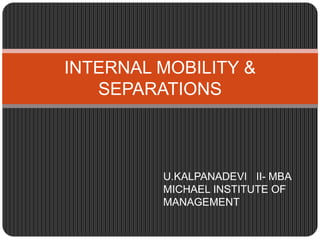
Internal mobility & separations
- 1. INTERNAL MOBILITY & SEPARATIONS U.KALPANADEVI II- MBA MICHAEL INSTITUTE OF MANAGEMENT
- 2. Employees move with in an organisation, laterally or vertically for a variety of reasons. To ensure the effectiveness of the employees in the organisation. To satisfy both employee & organisational needs. To provide for career & succession planning. To effect changes in jobs & organisational structure. To ensure discipline and make organisational rewards contingent on employee performance.
- 3. OPromotion ODemotion Vertical movement OTransfer of employees OSeparation (better prospects, retirement, termination etc…,)
- 4. PROMOTION • Upward movement of employees from one job to another higher one • With increase in salary, status, responsibilities • May be temporary or permanent • In-build motivational value • Removes feelings of stagnation and frustation • Good promotional policy to fill the vacancies in a higher job.
- 5. PURPOSES/OBJECTIVES To recognize an employees skill and knowledge To reward and motivate employees to higher productivity To promote employees satisfaction To build loyalty among the employees To promote good Human relations. To retain skilled and talented people To attract trained, competent and hard working people.
- 6. TYPES OF PROMOTION • Horizontal Promotion • Vertical Promotion • Dry Promotion
- 7. Promotion can be made on various bases: Seniority Merit Educational and Technical qualification Potential for better performance Career and succession plan Vacancies based on organisational charts Training Motivational strategies like Job enlargement
- 8. • Lateral movement of employees within the same grade. “ a transfer is a change in the job of an employees without a change in responsibilities or remuneration” - Edwin Flippo
- 9. • To meet organisational needs • To satisfy employee needs • To better utilize employee • To make the employee more Versatile • To adjust the workforce • To provide relief • To punish employee
- 10. • Production Transfer • Remedial Transfer • Replacement Transfer • Versatility Transfer • Shift Transfer • Penalty Transfer
- 11. • Specify the circumstances under which transfers will be made. • Specify the basis for transfer. • Intimate the fact of transfer to the person concered well in advance. • Clarify whether transfer is permanent or temporary. • Not to be made frequently.
- 12. Advantages: • Improve employee skills • Reduce monotony and boredom • Remedy faulty placement decisions • Prepare the employee for challenging assignments in future • Stabilize changing work requirements in different departments • Improve employee satisfaction and morale • Improve employer-employee relations
- 13. Disadvantages: • Inconvenient to employees who otherwise don’t want to move • Employees may or may not fit in the new location/department • Shifting of experienced hands may affect productivity • Discriminatory transfers may affect employee morale
- 14. • It is just opposite of promotion. • It is the downward movement of an employee in the organisational hierarchy with lower rank/status and pay. “the assignment of an individual to a job of lower rank and pay usually involving lower level of difficulty and responsibility” - D.S.Beach.
- 15. Causes • Incompetence- inability to meet the challenges posed by the new higher job • Adverse Business Conditions- Circumstances and conditions like recession and other crisis • Disciplinary measures- Disciplinary action against erring employees
- 16. Effects of Demotion Status, Pride, Career and income of the employee Causes feel of insecurity in employees mind Can create positive impact on employee’s morale and career planning It can generate disciplinary care in other employees
- 17. Meaning • It is situation when the service agreement of employees with his organization comes to an end and employee leaves the organization. • It is a decision that the individual and organization part from each other.
- 18. Forms of Separation Retirement- - Compulsory - Voluntary (golden handshake) Resignation Layoffs Retrenchments Dismissal
- 19. Employee Separation Reasons for employee separations: Pressures on firms to remain competitive and efficient Decline in employee commitment to individual employers The importance of managing separations: Transitions of employees out of the firm go smoothly. Continuing operations of the firm are not disrupted. Important professional relationships are not damaged. Types of separations Reductions-in-force, turnover, and retirements Copyright © 2002 South-Western. 00–19 All rights reserved.
- 20. Reductions-in-Force (RIFs) Causes of reductions: Restructuring as a result of mergers and acquisitions Attempts to make the organization more cost competitive Adjustments to declining business environment conditions Reasons for reductions: Inefficiency in operations Lack of adaptability in the marketplace A weakened competitive position in the industry Methods for dealing with reductions: Continuance pay and outplacement programs Copyright © 2002 South-Western. 00–20 All rights reserved.
- 21. Reductions-in-Force (RIFs) Worker Adjustment Retraining and Notification Act (WARN) of 1989: Requires employers with more than 100 employees to provide affected employees with a minimum of sixty days written notice of any facility closings or large-scale layoffs of 50 or more employees. WARN does no apply to governmental agencies. Exceptions to WARN: “unforeseeable circumstance” natural disaster “temporary facility” Copyright © 2002 South-Western. 00–21 All rights reserved.
- 22. Workforce Management Strategies EXHIBIT 13-1: STRATEGIES FOR MANAGING EMPLOYEE SURPLUSES AND AVOIDING LAYOFFS Copyright © 2002 South-Western. 00–22 All rights reserved.
- 23. Turnover Involuntary turnover Employees who are asked to leave the organization for cause (e.g., poor performance) or due to circumstances that cause a reduction-in-force. Voluntary turnover Employees who leave an organization on their own initiative. “Beneficial” turnover When low performing employees depart and/or when new higher performing employees are promoted or hired as replacements. Copyright © 2002 South-Western. 00–23 All rights reserved.
- 24. Retirement Age Discrimination Act of 1967 Prohibits an employer from setting a mandatory retirement age except in certain occupations such as airline pilots. Retirement Creates advancement opportunities for younger employees and reduces payroll costs. Can cause a loss of vital accumulated historical knowledge of the organization, its industry and the marketplace. Employers can offer part-time and consulting work to older workers to ease the transition to retirement. Copyright © 2002 South-Western. 00–24 All rights reserved.
